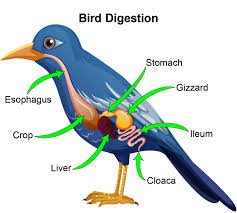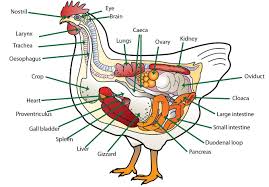Birds’ guts have important differences from mammals’ guts. Most obviously, birds have a beak instead of teeth. Beaks are much lighter than teeth and are an adaptation for flight. Imagine a bird trying to take off and fly with a whole set of teeth in its head!
At the base of the oesophagus birds have a bag-like structure called a crop. In many birds the crop stores food before it enters the stomach, while in pigeons and doves glands in the crop secretes a special fluid called crop-milk which parent birds regurgitate to feed their young.
The stomach is also modified and consists of two compartments. The first is the true stomach with muscular walls and enzyme secreting glands. The second compartment is the gizzard. In seed eating birds this has very muscular walls and contains pebbles swallowed by the bird to help grind the food.
This is the reason why you must always supply a caged bird with grit. In birds of prey like the falcon the walls of the gizzard are much thinner and expand to accommodate large meals.
Read Also: All You Need To Know About Animal Shelters
The Digestive Process in Birds

During digestion the large food molecules are broken down into smaller molecules by enzymes. The three most important groups of enzymes secreted into the gut are:
- Amylases that split carbohydrates like starch and glycogen into monosaccharides like glucose.
- Proteases that split proteins into amino acids.
- Lipases that split lipids or fats into fatty acids and glycerol.
Glands produce various secretions which mix with the food as it passes along the gut. These secretions include:
- Saliva secreted into the mouth from several pairs of salivary glands. Saliva consists mainly of water but contains salts, mucous and salivary amylase. The function of saliva is to lubricate food as it is chewed and swallowed and salivary amylase begins the digestion of starch.
- Gastric juice secreted into the stomach from glands in its walls. Gastric juice contains pepsin that breaks down protein and hydrochloric acid to produce the acidic conditions under which this enzyme works best. In baby animals rennin to digest milk is also produced in the stomach.
- Bile produced by the liver. It is stored in the gall bladder and secreted into the duodenum via the bile duct. (Note that the horse, deer, parrot and rat have no gall bladder). Bile is not a digestive enzyme. Its function is to break up large globules of fat into smaller ones so the fat splitting enzymes can gain access the fat molecules.
Pancreatic Secretions
The pancreas is a gland located near the beginning of the duodenum. In most animals it is large and easily seen but in rodents and rabbits it lies within the membrane linking the loops of the intestine (the mesentery) and is quite difficult to find.
Pancreatic juice is produced in the pancreas. It flows into the duodenum and contains amylase for digesting starch, lipase for digesting fats and protease for digesting proteins.
Intestinal Function
Intestinal juice is produced by glands in the lining of the small intestine. It contains enzymes for digesting disaccharides and proteins as well as mucus and salts to make the contents of the small intestine more alkaline so the enzymes can work.
Nutrient Absorption
The small molecules produced by digestion are absorbed into the villi of the wall of the small intestine. The tiny finger-like projections of the villi increase the surface area for absorption.
Glucose and amino acids pass directly through the wall into the blood stream by diffusion or active transport. Fatty acids and glycerol enter vessels of the lymphatic system (lacteals) that run up the centre of each villus.
Read Also: All You Need To Know About Sweet William Flowers
The Liver’s Vital Roles

The liver is situated in the abdominal cavity adjacent to the diaphragm. It is the largest single organ of the body and has over 100 known functions. Its most important digestive functions are:
- The production of bile to help the digestion of fats (described above)
- The control of blood sugar levels
Glucose is absorbed into the capillaries of the villi of the intestine. The blood stream takes it directly to the liver via a blood vessel known as the hepatic portal vessel or vein.
The liver converts this glucose into glycogen which it stores. When glucose levels are low the liver can convert the glycogen back into glucose. It releases this back into the blood to keep the level of glucose constant. The hormone insulin, produced by special cells in the pancreas, controls this process.
Additional Liver Functions Include:
Producing heat to help maintain the temperature of the body
Making vitamin A
Making the proteins that are found in the blood plasma (albumin, globulin and fibrinogen)
Storing iron
Removing toxic substances like alcohol and poisons from the blood and converting them to safer substances
Do you have any questions, suggestions, or contributions? If so, please feel free to use the comment box below to share your thoughts. We also encourage you to kindly share this information with others who might benefit from it. Since we can’t reach everyone at once, we truly appreciate your help in spreading the word. Thank you so much for your support and for sharing!

